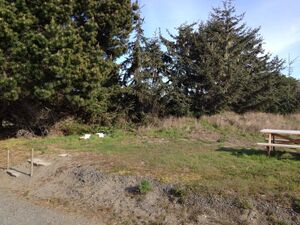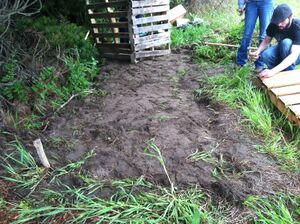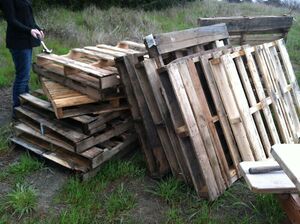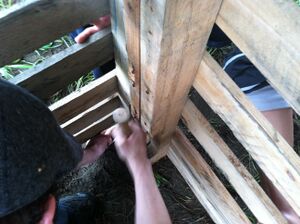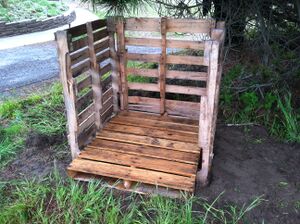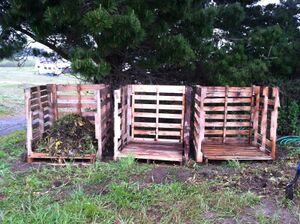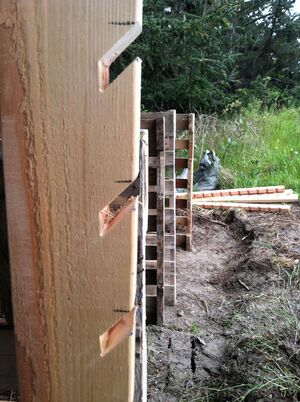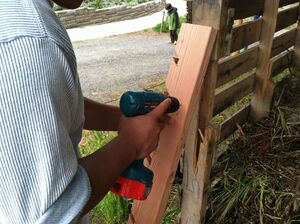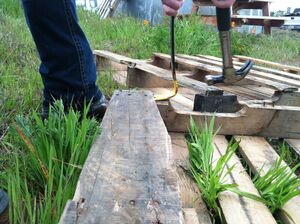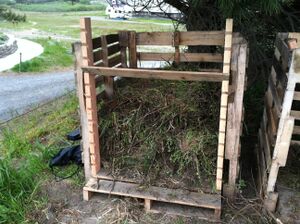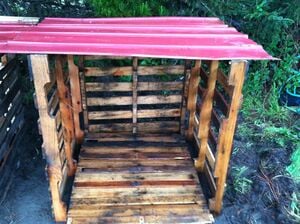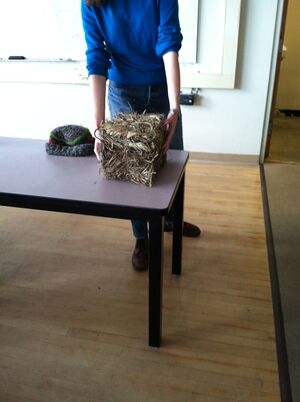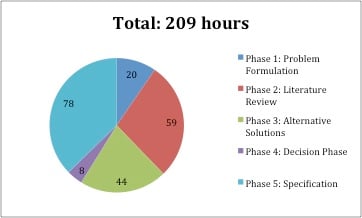Sophivorus (talk | contribs) m (Rename "affiliations" parameter to "organizations", to unify terminology throughout Appropedia) |
|||
| (21 intermediate revisions by 10 users not shown) | |||
| Line 1: | Line 1: | ||
[[File:Team6placein3chambers.jpg|thumb]] | |||
== | {{Project data | ||
| authors = User:Lg137, User:Makennawaterfield, Team 6 | |||
| status = Prototyped | |||
| instance-of = Compost bin | |||
| location = Arcata, California | |||
}} | |||
A rapid composting system was designed by [[ | A rapid composting system was designed by [[Engr205 Introduction to Design]] Team 6 to find a better use for the green waste generated at the [http://web.archive.org/web/20160223061101/http://www.friendsofthedunes.org:80/HCNC/ Humboldt Coastal Nature Center]. Below is a detailed page on the process and cost of building the rapid [[compost]] system. | ||
== Problem Statement == | == Problem Statement == | ||
The [[Friends of the Dunes]] invites volunteers every week to remove invasive plants in the [http://www.friendsofthedunes.org/HCNC/ Humboldt Coastal Nature Center]. Each week, a volume of approximately | The [[Friends of the Dunes]] invites volunteers every week to remove invasive plants in the [http://web.archive.org/web/20160223061101/http://www.friendsofthedunes.org:80/HCNC/ Humboldt Coastal Nature Center]. Each week, a volume of approximately 6'x6'x6' of green waste is generated and shipped off the site to be disposed of miles away. In an effort to manage the waste on site, rather than shipping it, this rapid composting system was designed. | ||
== Criteria == | == Criteria == | ||
{| class="wikitable | {| class="wikitable" | ||
| align="center"| Criteria | |||
|align="center"| Criteria | | align="center"| Weight | ||
|align="center"| Weight | | align="center"| Constraint | ||
|align="center"| Constraint | |||
|- | |- | ||
| Cost | | Cost | ||
|align="center"| 4 | | align="center"| 4 | ||
|align="left"| Less than $400 | | align="left"| Less than $400 | ||
|- | |- | ||
| Ease of Use | | Ease of Use | ||
|align="center"| 7 | | align="center"| 7 | ||
|align="left"| Usable by untrained volunteers | | align="left"| Usable by untrained volunteers | ||
|- | |- | ||
| | | Educational Value | ||
|align="center"| 6 | | align="center"| 6 | ||
|align="left"| At least volunteers learn more about rapid compost systems | | align="left"| At least volunteers learn more about rapid compost systems | ||
|- | |- | ||
| | | Effectiveness | ||
|align="center"| 9 | | align="center"| 9 | ||
|align="left"| Must be able to process about | | align="left"| Must be able to process about 6'x6'x6' of yard waste every 14-21 days | ||
|- | |- | ||
| | | Labor Intensity | ||
|align="center"| 5 | | align="center"| 5 | ||
|align="left"| Cannot require more maintenance than 1-2 times a week for 2-3 hours each day | | align="left"| Cannot require more maintenance than 1-2 times a week for 2-3 hours each day | ||
|- | |- | ||
| | | Availability of Amendments | ||
|align="center"| 2 | | align="center"| 2 | ||
|align="left"| Bought locally and cheaply | | align="left"| Bought locally and cheaply | ||
|- | |- | ||
| | | Aesthetics | ||
|align="center"| 6 | | align="center"| 6 | ||
|align="left"| More professional than a tarp | | align="left"| More professional than a tarp | ||
|- | |- | ||
| | | Safety | ||
|align="center"| 10 | | align="center"| 10 | ||
|align="left"| Non-toxic and will not spontaneously combust | | align="left"| Non-toxic and will not spontaneously combust | ||
|- | |- | ||
| | | Durability | ||
|align="center"| 8 | | align="center"| 8 | ||
|align="left"| Stable for at least one year | | align="left"| Stable for at least one year | ||
|} | |} | ||
== Description of Final Project == | == Description of Final Project == | ||
The rapid compost system is a three chamber compost bin with no mechanical parts. The structure is supported by wood beams and insulated with beach grass bales. To protect the insulating bales from wet weather, a hand mixed lime plaster seals the walls. The ground under the structure has been compacted thoroughly and covered with wood pallets to prevent the compost materials from contacting the earth. A roof will be slightly larger than the structure, and pitched at an angle, to keep rain from soaking through the plaster. Doors were made from donated wood that slides into place. | The rapid compost system is a three chamber compost bin with no mechanical parts. The structure is supported by wood beams and insulated with beach grass bales. To protect the insulating bales from wet weather, a hand mixed lime plaster seals the walls. The ground under the structure has been compacted thoroughly and covered with wood pallets to prevent the compost materials from contacting the earth. A roof will be slightly larger than the structure, and pitched at an angle, to keep rain from soaking through the plaster. Doors were made from donated wood that slides into place. | ||
{{ | {{Step | ||
| number = 1 | |||
| | | text = Find an open space. | ||
|File: | | image = File: FOTD Compost Location.jpg | ||
| | | caption = Project Site | ||
}} | |||
{{Step | |||
| number = 2 | |||
| text = Compress and flatten the ground where the compost bin will go. | |||
| image = File:Team 6.jpg | |||
| caption = Three Chamber compost System | |||
}} | |||
{{Step | |||
| number = 3 | |||
| text = Find some pallets to build the frame of the composter. Pallets can be found almost anywhere that receives freight. One of the best places to search are hardware stores, who will often give away the pallets for free. | |||
| image = File:Team6pallets.jpg | |||
| caption = Three Chamber compost System the 2nd | |||
}} | |||
{{Step | |||
| number = 4 | |||
| text = Nail three pallets together to make a chamber for the compost. | |||
| image = File:Team6Lukehummering.jpg | |||
| caption = Some picture | |||
}} | |||
{{Step | |||
| number = 5 | |||
| text = Place another pallet at the bottom of the chamber. This pallet will prevent the compost materials from contacting the ground while also allowing air to enter the compost bin form below. | |||
| image = File:Team6singlechamber.jpg | |||
| caption = Some random picture | |||
}} | |||
{{Step | |||
| number = 6 | |||
| text = Because of the large amount of waste being generated at Friends of the Dunes, three chambers were built. One or two chambers would be more appropriate for individual households. | |||
| image = File:Team6threechamber.jpg | |||
| caption = Some picture | |||
}} | |||
{{Step | |||
| number = 7 | |||
| text = Take six boards that are about the height of each chamber and cut slots into them. These slots will be placeholders for planks of wood which will make the door. | |||
| image = File:Team6cutslots.jpg | |||
| caption = Slots for door | |||
}} | |||
{{Step | |||
| number = 8 | |||
| text = Drill the boards directly onto the chamber walls. | |||
| image = File:Team6drillslots.jpg | |||
| caption = Some picture | |||
}} | |||
{{Step | |||
| number = 9 | |||
| text = Take any extra pallets you may have and remove the planks of wood. This wood is perfect for doors and will save money since pallets are free. | |||
| image = File:Team6woodenslots.jpg | |||
| caption = Some random picture | |||
}} | |||
{{Step | |||
| number = 10 | |||
| text = Place the planks of wood into the slots. | |||
| image = File:Team6placeslots.jpg | |||
| caption = Some picture | |||
}} | |||
{{Step | |||
| number = 11 | |||
| text = Once all planks are in place, the door will be complete. | |||
| image = File:Team6placein3chambers.jpg | |||
| caption = Some picture | |||
}} | |||
{{Step | |||
| number = 12 | |||
| text = Latch on a metal roof to protect the compost materials from rain. | |||
| image = File:Team6roof.JPG | |||
| caption = Some picture | |||
}} | |||
{{Step | |||
| number = 13 | |||
| text = Properly insulate the chambers by placing straw bales around the system. In our design we used beach grass because it is an invasive plant that is always readily available. | |||
| image = File:Team6beachgrass.jpg | |||
| caption = Beach Grass Bale | |||
}} | }} | ||
== Materials Cost == | == Materials Cost == | ||
{| class="wikitable | {| class="wikitable" | ||
! align="center"| Materials | |||
!align="center"| Materials | ! align="center"| Quantity | ||
!align="center"| Quantity | ! align="center"| Potential Cost | ||
!align="center"| Potential Cost | ! align="center"| Our Cost | ||
!align="center"| Our Cost | |||
|- | |- | ||
| Pallets | | Pallets | ||
|align="right"| 3 | | align="right"| 3 | ||
|align="center"| $23.75/pallet | | align="center"| $23.75/pallet | ||
|align="right"| Donated | | align="right"| Donated | ||
|- | |- | ||
| Beach Grass Bales | | Beach Grass Bales | ||
|align="right"| 18 | | align="right"| 18 | ||
|align="center"| Free | | align="center"| Free | ||
|align="right"| Donated | | align="right"| Donated | ||
|- | |- | ||
| Straw Bales | | Straw Bales | ||
|align="right"| 18 | | align="right"| 18 | ||
|align="center"| $9.12/bale | | align="center"| $9.12/bale | ||
|align="right"| $9.12/bale | | align="right"| $9.12/bale | ||
|- | |- | ||
| Lime Plaster | | Lime Plaster | ||
|align="right"| 48ft<sup>2</sup> | | align="right"| 48ft<sup>2</sup> | ||
|align="center"| $50.00 | | align="center"| $50.00 | ||
|align="right"| $50.00 | | align="right"| $50.00 | ||
|- | |- | ||
| Wood | | Wood | ||
|align="right"| twelve | | align="right"| twelve 2"x4"x4' | ||
|align="center"| Free | | align="center"| Free | ||
|align="right"| Free | | align="right"| Free | ||
|- | |- | ||
| Nails and Wire Staples | | Nails and Wire Staples | ||
|align="right"| 1lb | | align="right"| 1lb | ||
|align="center"| $2.49/lb | | align="center"| $2.49/lb | ||
|align="right"| Donated | | align="right"| Donated | ||
|- | |- | ||
| Chicken Wire | | Chicken Wire | ||
|align="right"| 48ft<sup>2</sup> | | align="right"| 48ft<sup>2</sup> | ||
|align="center"| $12.00 | | align="center"| $12.00 | ||
|align="right"| $12.00 | | align="right"| $12.00 | ||
|- | |- | ||
| Rebar | | Rebar | ||
|align="right"| five 4' bars | | align="right"| five 4' bars | ||
|align="center"| $3.00/bar | | align="center"| $3.00/bar | ||
|align="right"| $3.00/bar | | align="right"| $3.00/bar | ||
|- | |- | ||
| Corrugated Sheet Metal | | Corrugated Sheet Metal | ||
|align="right"| one 4'x15' sheet | | align="right"| one 4'x15' sheet | ||
|align="center"| Free | | align="center"| Free | ||
|align="right"| Free | | align="right"| Free | ||
|-class="sortbottom" | |- class="sortbottom" | ||
!colspan="2" align="center" | '''Total with Beach Grass Bales''' | ! colspan="2" align="center" | '''Total with Beach Grass Bales''' | ||
!align="right"|'''$161.24''' | ! align="right"|'''$161.24''' | ||
!align="right"| '''$86.00''' | ! align="right"| '''$86.00''' | ||
|} | |} | ||
==== Design Cost ==== | |||
===== Figure 8: Time Invested ===== | |||
[[File: Group Time input.jpg|upright=2.7]] | |||
== | == Update October 2017 == | ||
Unfortunately the rapid compost system fell apart and is no longer available to compost green waste. An employee said that, "They were not used as often as they would have liked." It was also mentioned that, "They fell over and it was a eye sore." | |||
{{Page data | |||
| part-of = Engr205 Introduction to Design | |||
| keywords = Compost bin, composting | |||
| sdg = SDG12 Responsible consumption and production | |||
| organizations = Friends of the Dunes, Cal Poly Humboldt | |||
}} | |||
[[Category: | [[Category:Composting]] | ||
Latest revision as of 18:04, 29 January 2024
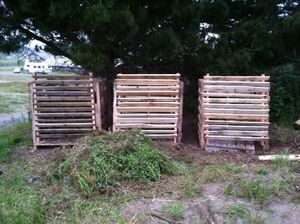
A rapid composting system was designed by Engr205 Introduction to Design Team 6 to find a better use for the green waste generated at the Humboldt Coastal Nature Center. Below is a detailed page on the process and cost of building the rapid compost system.
Problem Statement[edit | edit source]
The Friends of the Dunes invites volunteers every week to remove invasive plants in the Humboldt Coastal Nature Center. Each week, a volume of approximately 6'x6'x6' of green waste is generated and shipped off the site to be disposed of miles away. In an effort to manage the waste on site, rather than shipping it, this rapid composting system was designed.
Criteria[edit | edit source]
| Criteria | Weight | Constraint |
| Cost | 4 | Less than $400 |
| Ease of Use | 7 | Usable by untrained volunteers |
| Educational Value | 6 | At least volunteers learn more about rapid compost systems |
| Effectiveness | 9 | Must be able to process about 6'x6'x6' of yard waste every 14-21 days |
| Labor Intensity | 5 | Cannot require more maintenance than 1-2 times a week for 2-3 hours each day |
| Availability of Amendments | 2 | Bought locally and cheaply |
| Aesthetics | 6 | More professional than a tarp |
| Safety | 10 | Non-toxic and will not spontaneously combust |
| Durability | 8 | Stable for at least one year |
Description of Final Project[edit | edit source]
The rapid compost system is a three chamber compost bin with no mechanical parts. The structure is supported by wood beams and insulated with beach grass bales. To protect the insulating bales from wet weather, a hand mixed lime plaster seals the walls. The ground under the structure has been compacted thoroughly and covered with wood pallets to prevent the compost materials from contacting the earth. A roof will be slightly larger than the structure, and pitched at an angle, to keep rain from soaking through the plaster. Doors were made from donated wood that slides into place.
Materials Cost[edit | edit source]
| Materials | Quantity | Potential Cost | Our Cost |
|---|---|---|---|
| Pallets | 3 | $23.75/pallet | Donated |
| Beach Grass Bales | 18 | Free | Donated |
| Straw Bales | 18 | $9.12/bale | $9.12/bale |
| Lime Plaster | 48ft2 | $50.00 | $50.00 |
| Wood | twelve 2"x4"x4' | Free | Free |
| Nails and Wire Staples | 1lb | $2.49/lb | Donated |
| Chicken Wire | 48ft2 | $12.00 | $12.00 |
| Rebar | five 4' bars | $3.00/bar | $3.00/bar |
| Corrugated Sheet Metal | one 4'x15' sheet | Free | Free |
| Total with Beach Grass Bales | $161.24 | $86.00 | |
Design Cost[edit | edit source]
Figure 8: Time Invested[edit | edit source]
Update October 2017[edit | edit source]
Unfortunately the rapid compost system fell apart and is no longer available to compost green waste. An employee said that, "They were not used as often as they would have liked." It was also mentioned that, "They fell over and it was a eye sore."
